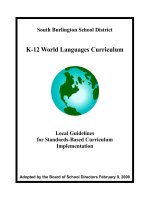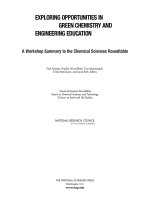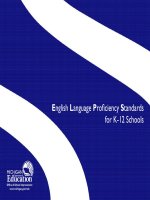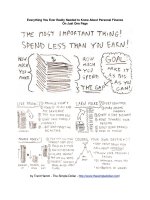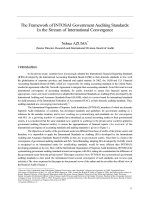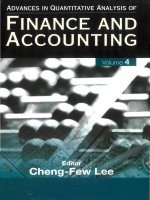National Standards in K–12 Personal Finance Education ppt
Bạn đang xem bản rút gọn của tài liệu. Xem và tải ngay bản đầy đủ của tài liệu tại đây (386.14 KB, 52 trang )
3rd
Edition,
2007
Jump$tart Coalition for Personal Financial Literacy
National
Standards
in K–12
Personal Finance
Education
With Benchmarks, Knowledge Statements, and Glossary
The publication of this booklet has been generously sponsored
by Charles Schwab Foundation.
Charles Schwab Foundation is a private, nonprot organization
funded by The Charles Schwab Corporation.
The Foundation is committed to fostering nancial literacy as
the basis for nancial well-being.
Jump$tart Coalition for Personal Financial Literacy
919 18th Street, NW, Suite 300
Washington, DC 20006-5517
Phone: 888–45 EDUCATE
www.jumpstartcoalition.org
Take the Challenge!
Something exciting is in the works for high school teachers and
their students. Twice a year, high school teachers are invited to
save a class period for the ongoing, National Financial Literacy
Challenge.
An initiative of the President’s Advisory Council on Financial
Literacy, this new recognition program will use a voluntary test
to determine and reward high levels of nancial literacy among
America’s high school students.
About the National Financial Literacy Challenge
The Challenge will be offered online, and will involve 35 questions on basic personal nance. It is
estimated that the Challenge will take the average student 40-45 minutes to complete. In most
instances, a computer lab will be required. Students scoring in the top 25th percentile of national
scores will be eligible for recognition from the President’s Advisory Council on Financial Literacy.
For more information
If you are a high school teacher, you may sign up for the ofcial distribution list by e-mailing
Be sure to include “Interest in National Financial Literacy Challenge” in your
subject line.
1 Introduction
2 Uses for the National Standards
3 Organization of the Standards
4 The Standards
6 How the National Standards Evolved
7 The Jump$tart Coalition and Its Mission
8 Financial Responsibility and Decision Making
11 Income and Careers
13 Planning and Money Management
17 Credit and Debt
20 Risk Management and Insurance
23 Saving and Investing
27 Knowledge Statements
33 Glossary
44 Independent Reviewers
Contents
Special thanks to the Federal Reserve Board and its staff for the original design and layout of this booklet.
1
The National Standards in K–12 Personal Finance
Education, created and maintained by the
Jump$tart Coalition® for Personal Financial Lit-
eracy, delineate the personal nance knowledge
and skills that K–12 students should possess.
The Jump$tart Coalition asserts that all young
people graduating from our nation’s high
schools should be able to take individual
responsibility for their personal economic well-
being. Broadly speaking, a nancially literate
high school graduate should know how to:
• Find, evaluate, and apply nancial information
• Set nancial goals and plan to achieve them
• Develop income-earning potential and the
ability to save
• Use nancial services effectively
• Meet nancial obligations
• Build and protect wealth
Many organizations have dened “personal
nance” and “nancial literacy.” The follow-
ing, a distillation of the views of several sources,
are the denitions underlying the National
Standards.
Personal nance describes the principles and
methods that individuals use to acquire and
manage income and assets.
Financial literacy is the ability to use knowl-
edge and skills to manage one’s nancial re-
sources effectively for lifetime nancial security.
Financial literacy is not an absolute state; it is a
continuum of abilities that is subject to variables
such as age, family, culture, and residence.
Financial literacy refers to an evolving state of
competency that enables each individual to re-
spond effectively to ever-changing personal and
economic circumstances.
Because of limited experience and responsibil-
ity, a typical recent high school graduate will
not exhibit the same degree of knowledge of
personal nance as a nancially literate older
adult. Financially literate high school graduates,
however, should have a general understanding
of all key aspects of personal nance. These
graduates will be condent in their ability to
nd and use the information required to meet
specic personal nance challenges as they
arise. To this end, the National Standards
in K–12 Personal Finance Education indicate
the skills students must have to increase their
personal nance knowledge continually as their
responsibilities and opportunities change.
The Jump$tart Coalition intends the National
Standards in K–12 Personal Finance Education
to serve as a model. As such, the National
Standards represent the framework of an ideal
personal nance curriculum, portions of which
might not be appropriate for individual instruc-
tors and students. The Coalition leaves it up to
various stakeholders to decide how to address
the topics in the National Standards.
Introduction
2
The revised and updated National Standards
in K–12 Personal Finance Education provide a
program design and evaluation framework for
school administrators, teachers, curriculum spe-
cialists, instructional materials developers, and
educational policymakers. At each of the three
benchmark grades—4th, 8th, and 12th—the
expectations describe skills and knowledge each
student should exhibit, not what should be
taught in that grade. Individual students might
have missed or not remember previous lessons.
In those cases, teachers can refer to earlier
expectations to identify areas of instruction on
which to concentrate.
Among the practical uses for the personal
nance standards and expectations are to:
• Suggest a range of content that students
should know and be able to act on
• Provide guidelines for evaluating published
educational materials
• Help to shape lesson plans, unit and course
outlines, learning activities, textbooks, and
other instructional materials
• Increase awareness of the need for personal
nance in the nation’s schools
After reviewing the 29 personal nance stan-
dards, educators may select topics that are
appropriate to the needs of diverse learners in
specic settings. Educators can use the stan-
Uses for the National Standards
dards and expectations to design new personal
nance units or courses, or to integrate con-
cepts into existing courses. To help accomplish
this, the Jump$tart Coalition provides the fol-
lowing additional resources:
Personal Finance Clearinghouse
The searchable, online Jump$tart Clearing-
house (www.jumpstartclearinghouse.org) can
help educators identify appropriate education-
al materials by several factors, including grade
level, format, and content category.
National Best Practices Guidelines
The Jump$tart Best Practices Guidelines
(www.jumpstart.org/bp.cfm) can help educa-
tors evaluate and select existing instructional
materials, help organizations improve pro-
grams that they already provide, and assist
designers in creating effective new personal
nance curricula.
The National Standards in K–12 Personal
Finance Education complement state and local
educational goals and standards. In states where
personal nance is not yet part of the state’s
K–12 educational objectives, the National Stan-
dards in K–12 Personal Finance Education can
help convince policymakers to include personal
nance in future state standards and student
achievement tests and guide their creation.
3
The National Standards in K–12 Personal Finance
Education describe the minimum requirements
for functional nancial literacy. They are orga-
nized as follows:
Standards
The K–12 standards trace a path to a minimal
level of competency upon completion of high
school. They describe what personal nance
instruction should enable students to know and
do. The standards fall into six major categories
of personal nance—Financial Responsibility
and Decision Making; Income and Careers; Plan-
ning and Money Management; Credit and Debt;
Risk Management and Insurance; and Saving
and Investing. Each category focuses on an
overall competency derived from the Jump$tart
Coalition’s denition of nancial literacy.
Expectations
The statements of expectation describe how
students can apply knowledge to everyday
nancial decisions and actions at three points
in their consumer development—at grades 4, 8,
and 12. The expectations reect a progression
of student learning in which increasing com-
plexity builds on earlier knowledge. Educators
will take into account that students learn at
different rates because of a variety of learning
styles, interests, and experiences outside the
classroom.
Knowledge Statements
These statements show relationships among
the key concepts underlying the standards and
expectations. They provide further guidance
for publishers as they develop and revise cur-
ricula and for educators as they select classroom
materials and plan lessons. Like the Glossary,
the Knowledge Statements are not meant to be
exhaustive.
Glossary
The list of denitions is meant as an aid to
understanding the Standards, Expectations,
and Knowledge Statements. It includes only a
sampling of key terms.
Organization of the Standards
4
Financial Responsibility and Decision Making
Overall Competency
Apply reliable information and systematic decision making to personal nancial decisions.
Standard 1: Take responsibility for personal nancial decisions.
Standard 2: Find and evaluate nancial information from a variety of sources.
Standard 3: Summarize major consumer protection laws.
Standard 4: Make nancial decisions by systematically considering alternatives and consequences.
Standard 5: Develop communication strategies for discussing nancial issues.
Standard 6: Control personal information.
Income and Careers
Overall Competency
Use a career plan to develop personal income potential.
Standard 1: Explore career options.
Standard 2: Identify sources of personal income.
Standard 3: Describe factors affecting take-home pay.
Planning and Money Management
Overall Competency
Organize personal nances and use a budget to manage cash ow.
Standard 1: Develop a plan for spending and saving.
Standard 2: Develop a system for keeping and using nancial records.
Standard 3: Describe how to use different payment methods.
Standard 4: Apply consumer skills to purchase decisions.
Standard 5: Consider charitable giving.
Standard 6: Develop a personal nancial plan.
Standard 7: Examine the purpose and importance of a will.
The Standards
5
Credit and Debt
Overall Competency
Maintain creditworthiness, borrow at favorable terms, and manage debt.
Standard 1: Identify the costs and benets of various types of credit.
Standard 2: Explain the purpose of a credit record and identify borrowers’ credit report rights.
Standard 3: Describe ways to avoid or correct debt problems.
Standard 4: Summarize major consumer credit laws.
Risk Management and Insurance
Overall Competency
Use appropriate and cost-effective risk management strategies.
Standard 1: Identify common types of risks and basic risk management methods.
Standard 2: Explain the purpose and importance of property and liability insurance protection.
Standard 3: Explain the purpose and importance of health, disability, and life insurance protection.
Saving and Investing
Overall Competency
Implement a diversied investment strategy that is compatible with personal goals.
Standard 1: Discuss how saving contributes to nancial well-being.
Standard 2: Explain how investing builds wealth and helps meet nancial goals.
Standard 3: Evaluate investment alternatives.
Standard 4: Describe how to buy and sell investments.
Standard 5: Explain how taxes affect the rate of return on investments.
Standard 6: Investigate how agencies that regulate nancial markets protect investors.
6
In 1998, the Jump$tart Coalition for Personal
Financial Literacy issued its rst Personal Finance
Guidelines and Benchmarks. A group of 20
professionals representing a broad range of
education, government, and nancial service or-
ganizations developed these original guidelines.
In 2001, and again in 2006, the Jump$tart
Coalition board authorized the formation of
a task force to revise and update the National
Standards in K–12 Personal Finance Education.
Members of the 2006 standards revision task
force included:
• Rosella Bannister, Jump$tart Personal Finance
Clearinghouse, Ann Arbor, Michigan
• Les Dlabay, Lake Forest College, Lake Forest,
Illinois
• Vickie Hampton, Texas Tech University, Lub-
bock, Texas
• Philip Heckman, Credit Union National As-
sociation, Madison, Wisconsin (Committee
Chair)
• Claudia Kerbel, University of Rhode Island,
Kingston, Rhode Island
• Nancy Lang, Northern Kentucky University,
Highland Heights, Kentucky
• Jacqueline Ward, Wisconsin Women’s Business
Initiative Corporation, Milwaukee, Wisconsin
Before and after the 2006 task force completed
major revisions, a select group (identied on
page 44) of business and nance industry pro-
fessionals and educators—which included class-
room teachers representing business education,
family and consumer science, and economics in
the social studies—reviewed the standards for
academic integrity, as well as practical applica-
tions. Reviewers’ suggestions led to substantial
improvements.
Identifying standards and expectations is not
an easy task, nor is it ever completely nished.
The Jump$tart Coalition for Personal Financial
Literacy considers this to be a living document,
one that it will continue to modify and expand
to meet the changing needs of personal nance
teachers and students.
How the National Standards Evolved
7
Jump$tart Coalition for Personal Financial
Literacy consists of 180 organizations and 47
afliated state coalitions dedicated to improving
the nancial literacy of youth from kindergarten
through college age by providing advocacy,
research, standards, and educational resources.
Jump$tart strives to prepare youth for lifelong
successful nancial decision making.
The Jump$tart Coalition
and Its Mission
8
Overall Competency
Apply reliable information and systematic decision making to personal nancial decisions.
Financial Responsibility
and Decision Making
Standard 1
Take responsibility
for personal nancial
decisions.
High school graduate can:
Explain how individuals demon-
strate responsibility for nancial
well-being over a lifetime.
Analyze how nancial responsi-
bility is different for individuals
with and without dependents.
Given a scenario, discuss ethical
considerations of various per-
sonal nance decisions.
8th grade student can:
Identify ways to be a nancially
responsible young adult.
Give examples of the benets of
nancial responsibility and the
costs of nancial irresponsibility.
4th grade student can:
List examples of nancial deci-
sions and their possible conse-
quences.
Identify ways to be a nancially
responsible youth.
12th Grade
Additional Expectations
8th Grade
Additional Expectations
4th Grade
Expectations
Standard 2
Find and evaluate
nancial information
from a variety of
sources.
4th grade student can:
Give examples of situations in
which nancial information
would lead to better decisions.
Identify sources of nancial
information.
8th grade student can:
Analyze and evaluate advertis-
ing claims.
Identify online and printed
sources of product informa-
tion and list the strengths and
weaknesses of each.
High school graduate can:
Determine whether nancial in-
formation is objective, accurate,
and current.
Investigate current types of
consumer fraud, including
online scams.
Given a scenario, identify
relevant nancial information
needed to make a decision.
List factors to consider when
selecting a nancial planning/
counseling professional and
legal/tax adviser.
9
12th Grade
Additional Expectations
8th Grade
Additional Expectations
4th Grade
Expectations
Standard 3
Summarize major
consumer protection
laws.
4th grade student can:
Compare product return poli-
cies at local retail stores.
8th grade student can:
Research the primary consumer
protection agency in the state
of residence.
Give examples of unfair or
deceptive business practices
that consumer protection laws
forbid.
Given a scenario, explain steps in
resolving a consumer complaint.
High school graduate can:
Match consumer protection
laws to descriptions of the is-
sues that they address and the
safeguards that they provide.
Research online and printed
sources of up-to-date informa-
tion about consumer rights.
Given a scenario, write a
complaint letter that states the
problem, asks for specic ac-
tion, includes copies of related
documents, and provides con-
tact information.
Standard 4
Make nancial
decisions by system-
atically considering
alternatives and
consequences.
4th grade student can:
Explain how limited personal
nancial resources affect the
choices people make.
Rank personal wants/needs in
order of importance.
Set measurable short-term
nancial goals.
Outline the steps in systemati-
cally evaluating alternatives and
making a decision.
Apply systematic decision mak-
ing to a short-term goal.
8th grade student can:
Set measurable short- and
medium-term nancial goals.
Prioritize personal nancial
goals.
Evaluate the results of a nan-
cial decision.
Use a nancial or online calcu-
lator to determine the cost of
achieving a medium-term goal.
Apply systematic decision mak-
ing to a medium-term goal.
High school graduate can:
Set measurable short-,
medium-, and long-term
nancial goals.
Use a nancial or online calcu-
lator to determine the cost of
achieving a long-term goal.
Apply systematic decision mak-
ing to a long-term goal.
Analyze how ination affects
nancial decisions.
Analyze how taxes affect nan-
cial decisions.
Give examples of how decisions
made today can affect future
opportunities.
Financial Responsibility
and Decision Making
10
12th Grade
Additional Expectations
8th Grade
Additional Expectations
4th Grade
Expectations
Standard 5
Develop communica-
tion strategies for
discussing nancial
issues.
4th grade student can:
Give examples of how mem-
bers of previous generations
spent money as children.
Analyze the values and atti-
tudes of members of previous
generations from their personal
stories about money.
8th grade student can:
Explain how discussing im-
portant nancial matters with
household members can help
reduce conict.
Identify differences among
peers’ values and attitudes
about money.
High school graduate can:
Explain the value of discussing
individual and shared nancial
responsibilities with a room-
mate before moving in.
Discuss the pros and cons of
sharing nancial goals and
personal nance information
with a partner before combin-
ing households.
Give examples of contracts be-
tween individuals and between
individuals and businesses,
and identify each party’s basic
responsibilities.
Standard 6
Control personal
information.
4th grade student can:
List types of personal infor-
mation that should not be
disclosed to others and the pos-
sible consequences of doing so.
8th grade student can:
List actions an individual can
take to protect personal identity.
Describe problems that oc-
cur when one is the victim of
identity theft.
Identify ways that thieves can
fraudulently obtain personal
information.
High school graduate can:
List entities that have a right to
obtain individual Social Security
numbers.
Recommend actions a victim
of identity theft should take to
restore personal security.
Financial Responsibility
and Decision Making
11
Overall Competency
Use a career plan to develop personal income potential.
Income and Careers
Standard 1
Explore career options.
12th Grade
Additional Expectations
8th Grade
Additional Expectations
4th Grade
Expectations
4th grade student can:
Explain the difference between
a career and a job and identify
various jobs in the community.
Give an example of how an
individual’s interests, knowl-
edge, and abilities can affect
career and job choice.
Identify a topic of personal
interest and research a career
related to that topic of interest.
Examine a job related to a
career of interest.
Give examples of entrepreneurs
in the community.
8th grade student can:
Give an example of how educa-
tion and/or training can affect
lifetime income.
Identify online and printed
sources of information
about jobs, careers, and
entrepreneurship.
Compare personal skills and in-
terests to various career options.
Describe the educational/train-
ing requirements, income
potential, and primary duties of
at least two jobs of interest.
Identify individuals who could
provide a positive job reference.
Complete an age-appropriate,
part-time job application,
including references.
High school graduate can:
Describe the risks, costs, and
rewards of starting a business.
Outline the main components
of a business plan.
Analyze how economic, social-
cultural, and political conditions
can affect income and career
potential.
Identify a career goal and de-
velop a plan and timetable for
achieving it, including educa-
tional/training requirements,
costs, and possible debt.
12
Standard 2
Identify sources of
personal income.
12th Grade
Additional Expectations
8th Grade
Additional Expectations
4th Grade
Expectations
4th grade student can:
Explain the difference between
a wage and a salary.
Identify jobs children can do to
earn money.
Give examples of sources of
income other than a wage or
salary.
8th grade student can:
Dene gift, rent, interest,
dividend, capital gain, tip,
commission, and business
prot income.
Explain the difference between
earned and unearned income
and give an example of each.
Give an example of a govern-
ment transfer payment.
Describe how a local government
assistance program can benet
people in the community.
High school graduate can:
Explain the effect of ination
on income.
Use a nancial or online calcu-
lator to determine the future
income needed to maintain a
current standard of living.
Standard 3
Describe factors
affecting take-home
pay.
4th grade student can:
Dene tax and explain the
difference between sales and
income taxes.
Give an example of how gov-
ernment uses tax revenues.
8th grade student can:
Explain all items commonly
withheld from gross pay.
Give examples of employee
benets and explain why they
are forms of compensation.
Explain the difference between
Social Security and Medicare
programs.
High school graduate can:
Explain the effect on take-home
pay of changing the allowances
claimed on an “Employee’s
Withholding Allowance Certi-
cate” (IRS form W-4).
Transfer information on “Wage
and Tax Statement” (IRS form
W-2) and “Interest Income”
(IRS form 1099-INT) to “U.S.
Individual Income Tax Return”
(IRS form 1040) and compa-
rable state income tax form.
Complete “Income Tax Return
for Single and Joint Filers with
No Dependents” (IRS form
1040EZ) and comparable state
income tax form.
Examine the benets of em-
ployer-sponsored savings plans
and other options for shifting
current income to the future.
Income and Careers
13
Overall Competency
Organize and plan personal nances and use a budget to manage cash ow.
Planning and Money Management
12th Grade
Additional Expectations
8th Grade
Additional Expectations
4th Grade
Expectations
Standard 1
Develop a plan for
spending and saving.
4th grade student can:
Give examples of household
expense categories and sources
of income.
Describe how to allocate a
weekly allowance among the
nancial goals of spending,
saving, and sharing.
8th grade student can:
Prepare a personal spending
diary.
Calculate the sales tax for a
given purchase.
Discuss the components of
a personal budget, includ-
ing income, planned saving,
taxes, and xed and variable
expenses.
Given a household case study,
calculate percentages for major
expense categories.
High school graduate can:
Explain how to use a budget to
manage spending and achieve
nancial goals.
Identify changes in personal
spending behavior that contrib-
ute to wealth-building.
Given a scenario, design a
personal budget for a young
person living alone.
Analyze how changes in
circumstances can affect a
personal budget.
Standard 2
Develop a system for
keeping and using
nancial records.
4th grade student can:
Prepare a personal property
inventory, including locations
and estimates of value.
8th grade student can:
Set up a le system for house-
hold product information
and warranties and nancial
documents such as receipts and
account statements.
High school graduate can:
Develop a ling system for
keeping nancial records, both
paper and electronic.
Describe recordkeeping fea-
tures that nancial institutions
provide for online account
management.
14
12th Grade
Additional Expectations
8th Grade
Additional Expectations
4th Grade
Expectations
Standard 3
Describe how to use
different payment
methods.
4th grade student can:
Describe different types of
local nancial institutions and
explain the differences between
them.
Explain how checks and debit
and credit cards work as pay-
ment methods.
8th grade student can:
Discuss the advantages and
disadvantages of different pay-
ment methods, such as stored-
value cards, debit cards, and
online payment systems.
Compare the features and costs
of a checking account and a
debit card offered by different
local nancial institutions.
Compare the costs of cashing a
third-party check at various lo-
cal nancial institutions, includ-
ing a check-cashing service.
High school graduate can:
Demonstrate skill in basic nan-
cial tasks, including scheduling
bill payments, writing a check,
reconciling a checking/debit
account statement, and moni-
toring printed and/or online ac-
count statements for accuracy.
Standard 4
Apply consumer skills
to purchase decisions.
4th grade student can:
Compare prices for the same
item at two different stores.
Apply systematic decision
making to a personal age-
appropriate purchase.
Explain how peer pressure can
affect spending decisions.
8th grade student can:
Explain the relationship be-
tween spending practices and
achieving nancial goals.
Give examples of how external
factors, such as marketing and
advertising techniques, might
inuence spending decisions
for different individuals.
Given an age-appropriate
scenario, describe how to use
systematic decision making
to choose among courses of
action that include a range of
spending and non-spending
alternatives.
High school graduate can:
Apply comparison shopping
skills to purchasing decisions.
Given a personal nance
scenario for a family of four,
describe how to apply system-
atic decision making to choose
among alternative consumer
actions.
Compare the benets and costs
of owning a house versus rent-
ing housing.
Explain the elements of a
standard apartment lease
agreement.
Describe the effect of ination
on buying power.
Planning and Money
Management
15
12th Grade
Additional Expectations
8th Grade
Additional Expectations
4th Grade
Expectations
Standard 5
Consider charitable
giving.
4th grade student can:
Identify a private charitable
organization and the people it
serves.
8th grade student can:
Determine whether charitable
giving ts one’s budget and, if
so, how much is appropriate.
High school graduate can:
Use online charity-rating
organizations to compare
information about specic
charities, such as the per-
centage of money spent on
programs versus salaries and
fundraising.
Standard 6
Develop a personal
nancial plan.
4th grade student can:
Give examples of household
assets.
8th grade student can:
Explain the difference, with
examples, between assets and
liabilities.
Given a simplied case study,
construct a net worth
statement.
High school graduate can:
Discuss the factors that affect
net worth.
Explain the difference, with ex-
amples, between cash inows
(including income) and cash
outows (including expense).
Explain the difference between
a cash ow statement and a
budget.
Given a simplied case study,
construct a cash ow
statement.
Develop, monitor, and modify a
personal nancial plan, includ-
ing goals, net worth statement,
cash ow statement, insurance
plan, investing plan, and a
budget.
Planning and Money
Management
16
12th Grade
Additional Expectations
8th Grade
Additional Expectations
4th Grade
Expectations
Standard 7
Examine the purpose
and importance of a
will.
Planning and Money
Management
4th grade student can:
Identify an item that a house-
hold member has inherited.
8th grade student can:
Research the age at which an
individual can write a valid will
in the state of residence.
Describe the main components
of a simple will and research
the typical cost of having one
drafted.
High school graduate can:
Identify the individuals and/or
charitable organizations that
are potential beneciaries of
personal property.
Explain how the law in the
state of residence species the
disposition of an estate when
there is no valid will.
Explain the purpose and impor-
tance of a “living will” (durable
power of attorney for health
care).
17
Overall Competency
Maintain creditworthiness, borrow at favorable terms, and manage debt.
Credit and Debt
12th Grade
Additional Expectations
8th Grade
Additional Expectations
4th Grade
Expectations
Standard 1
Identify the costs and
benets of various
types of credit.
4th grade student can:
Explain the difference between
buying with cash and buying
with credit.
Describe the advantages and
disadvantages of using credit.
Explain why nancial institu-
tions lend money.
Identify credit purchases that
adults commonly make.
Explain why using a credit card
is a form of borrowing.
8th grade student can:
Explain how debit cards differ
from credit cards.
Explain how interest rate and
loan length affect the cost of
credit.
Using a nancial or online
calculator, determine the total
cost of repaying a loan under
various rates of interest and
over different periods.
Give examples of “easy access”
credit.
Given an “easy access” loan
amount and a two-week bor-
rowing fee, calculate the inter-
est rate for the loan period and
its annual equivalent.
Discuss potential consequences
of using “easy access” credit.
Explain how students, home-
owners, and business owners
use debt as an “investment.”
Explain the potential conse-
quences of deferred payment
of student loans.
High school graduate can:
Compare the cost of borrowing
$1,000 by means of different
consumer credit options.
Dene all required credit card
disclosure terms and complete
a typical credit card application.
Explain how credit card grace
periods, methods of interest
calculation, and fees affect bor-
rowing costs.
Using a nancial or online cal-
culator, compare the total cost
of reducing a $1,000 credit
card balance to zero with mini-
mum payments versus above-
minimum payments.
Given a scenario, apply system-
atic decision making to identify
the most cost-effective option
for purchasing a car.
Identify various types of student
loans and alternatives to loans
as a means of paying for post-
secondary education.
Identify various types of
mortgage loans and mortgage
lenders.
18
12th Grade
Additional Expectations
8th Grade
Additional Expectations
4th Grade
Expectations
Standard 2
Explain the purpose
of a credit record and
identify borrowers’
credit report rights.
Credit and Debt
4th grade student can:
Describe the qualities that
would be desirable in a person
who borrows a favorite per-
sonal possession.
Give examples of reasonable
conditions to set for the use of
borrowed personal property.
Given a scenario, describe
steps that a person could take
to regain a lender’s trust after
losing or damaging borrowed
personal property.
8th grade student can:
Explain why it is important to
establish a positive credit
history.
Explain the value of credit
reports to borrowers and to
lenders.
Describe the information in a
credit report and how long it is
retained.
Give examples of permissible
uses of a credit report other
than granting credit.
High school graduate can:
Describe the elements of a
credit score.
Explain how a credit score af-
fects creditworthiness and the
cost of credit.
Explain the factors that improve
a credit score.
Identify organizations that
maintain consumer credit
records.
Explain the rights that people
have to examine their credit
reports.
Analyze the information
contained in a credit report,
indicate the time that certain
negative data can be retained,
and describe how to dispute
inaccurate entries.
Discuss ways that a nega-
tive credit report can affect a
consumer’s nancial future.
19
12th Grade
Additional Expectations
8th Grade
Additional Expectations
4th Grade
Expectations
Standard 3
Describe ways to
avoid or correct credit
problems.
Credit and Debt
4th grade student can:
List ways to avoid credit
problems, including not
overspending.
8th grade student can:
Give examples of legal and il-
legal debt collection practices.
Identify possible indicators of
excessive debt.
High school graduate can:
Describe possible consequences
of excessive debt.
List actions that a consumer
could take to reduce or better
manage excessive debt.
Evaluate various credit counsel-
ing services.
Describe the purpose of bank-
ruptcy and its possible effects
on assets, employability, and
credit cost and availability.
Given a scenario, write a bill-
ing dispute letter that states
the problem, asks for specic
action, includes references to
copies of related documents,
and provides contact
information.
Describe debtors’ and creditors’
rights related to wage garnish-
ment and repossession when
an overdue debt is not paid.
Standard 4
Summarize major
consumer credit laws.
8th grade student can:
Give examples of protections
derived from consumer credit
laws.
High school graduate can:
Summarize consumer credit
laws and the protections that
they provide.
Research online and printed
sources of up-to-date informa-
tion about consumer credit
rights.
20
Overall Competency
Use appropriate and cost-effective risk management strategies.
Risk Management and Insurance
12th Grade
Additional Expectations
8th Grade
Additional Expectations
4th Grade
Expectations
Standard 1
Identify common types
of risks and basic
risk management
methods.
4th grade student can:
Give examples of risks that indi-
viduals and households face.
Given an age-appropriate
activity such as riding a bicycle,
analyze how to reduce and
avoid different kinds of risk.
8th grade student can:
Discuss the relationship be-
tween risk and insurance.
Explain how insurance deduct-
ibles work.
Determine how to evaluate an
extended warranty.
High school graduate can:
Give examples of how people
manage risk through avoid-
ance, reduction, retention, and
transfer.
Explain how to self-insure and
give examples of circumstances
in which self-insurance is
appropriate.
Recommend insurance for the
types of risks that young adults
might face.
21
Standard 2
Explain the purpose
and importance of
property and liability
insurance protection.
12th Grade
Additional Expectations
8th Grade
Additional Expectations
4th Grade
Expectations
Risk Managment and
Insurance
4th grade student can:
List valuable items that house-
holds commonly own.
Describe how valuable items
might be damaged or lost and
ways to protect them.
8th grade student can:
Identify the types of insurance
that might cover accidental
damage to another person’s
property.
Give examples of the kinds of
expenses that a typical auto
insurance policy covers.
Give examples of the kinds of
expenses that a typical renter’s
policy and a typical homeown-
er’s policy cover.
Identify the factors that inu-
ence the cost of insurance for
vehicles and housing.
High school graduate can:
Differentiate among the main
types of auto insurance
coverage.
List factors that can increase or
reduce auto insurance
premiums.
Determine the legal minimum
amounts of auto insurance
coverage required in one’s state
of residence and recommend
optimal amounts.
Given a scenario, calculate the
amount paid on an insurance
claim after applying exclusions
and deductibles.
Compare the costs of auto
insurance for the same vehicle,
given two different deductibles
and two different liability cover-
age limits.
Explain the benets of renter’s
insurance and compare policies
from different companies.
